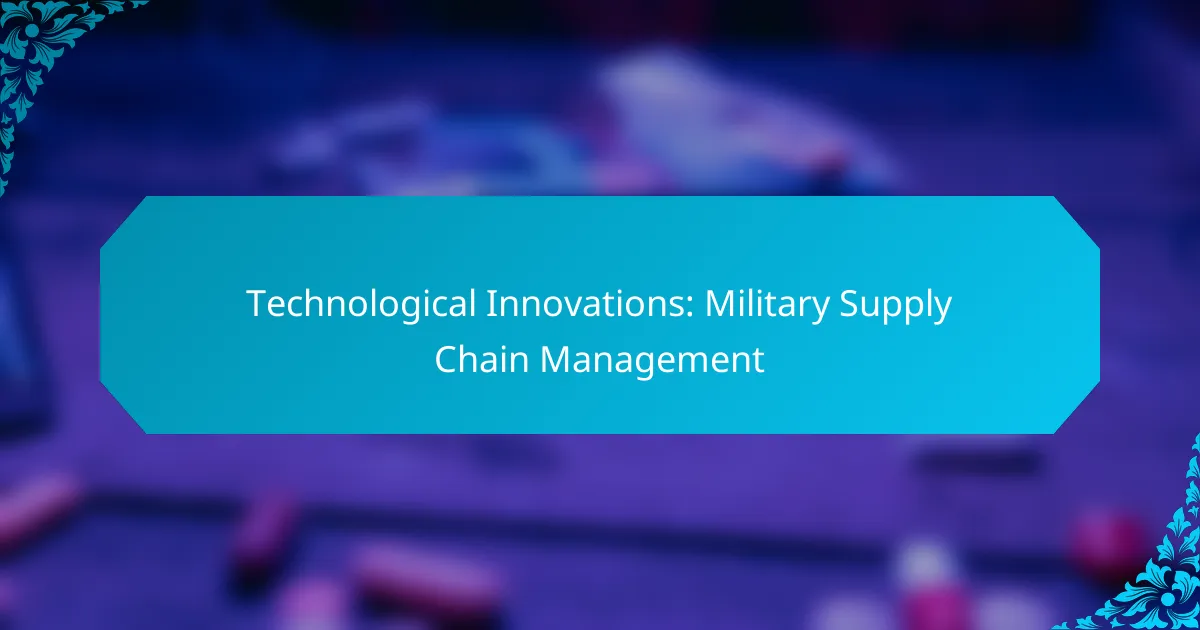Technological innovations in military supply chain management, such as blockchain, artificial intelligence, and the Internet of Things, play a crucial role in enhancing logistics efficiency and responsiveness. By streamlining processes and optimizing resource allocation, these advancements significantly improve operational readiness. However, challenges like high initial costs and data security concerns must be addressed to fully realize their potential.

What Are the Key Technological Innovations in Military Supply Chain Management?
Key technological innovations in military supply chain management include blockchain, artificial intelligence, the Internet of Things, robotics, and cloud computing. These technologies enhance efficiency, transparency, and responsiveness in logistics operations, which are crucial for military effectiveness.
Blockchain for transparency
Blockchain technology provides a secure and transparent way to track transactions and movements within the military supply chain. By creating an immutable ledger, it ensures that all parties have access to the same information, reducing the risk of fraud and errors.
Implementing blockchain can streamline processes such as procurement and inventory management. For instance, using smart contracts can automate payments and approvals, significantly speeding up operations while maintaining accountability.
AI for predictive analytics
Artificial intelligence (AI) enhances military supply chain management through predictive analytics, allowing for better demand forecasting and resource allocation. By analyzing historical data and current trends, AI can predict future needs, helping to prevent shortages or overstock situations.
For example, AI algorithms can analyze factors like troop movements and equipment usage to optimize supply levels. This proactive approach can lead to cost savings and improved operational readiness.
IoT for real-time tracking
The Internet of Things (IoT) enables real-time tracking of supplies and equipment throughout the military supply chain. By using connected devices, military logistics can monitor the location and condition of assets, ensuring timely deliveries and reducing losses.
For instance, GPS-enabled sensors can provide updates on the status of shipments, allowing for immediate adjustments if delays occur. This capability enhances situational awareness and operational efficiency.
Robotics for automation
Robotics plays a crucial role in automating various supply chain tasks, from warehousing to transportation. Automated systems can handle repetitive tasks, such as picking and packing, which increases efficiency and reduces human error.
In military contexts, autonomous vehicles can transport supplies to remote locations, minimizing risk to personnel. This technology not only speeds up logistics but also allows for more flexible and responsive operations.
Cloud computing for data integration
Cloud computing facilitates data integration across different military supply chain systems, enabling seamless communication and collaboration. By centralizing data storage, military organizations can access real-time information from various sources, improving decision-making.
Utilizing cloud-based platforms allows for scalability and flexibility, accommodating changing needs without significant infrastructure investments. This approach can enhance overall supply chain resilience and adaptability in dynamic environments.

How Do These Innovations Improve Efficiency?
Technological innovations in military supply chain management significantly enhance efficiency by streamlining processes, reducing delays, and optimizing resource allocation. These advancements lead to faster response times and better utilization of assets, ultimately improving operational readiness.
Reduced lead times
Innovations such as automated ordering systems and real-time tracking reduce lead times in military supply chains. By leveraging technologies like artificial intelligence and machine learning, military organizations can predict demand more accurately and adjust supply levels accordingly.
For instance, using predictive analytics can help anticipate the need for spare parts, allowing for orders to be placed proactively. This can cut lead times from weeks to days, ensuring that critical supplies are available when needed.
Enhanced inventory management
Advanced inventory management systems utilize RFID and IoT devices to provide real-time visibility into stock levels. This technology allows military supply chains to maintain optimal inventory levels, reducing excess stock and minimizing shortages.
By implementing just-in-time inventory practices, military units can ensure that they have the right amount of supplies on hand without overstocking. This approach not only saves costs but also enhances the agility of the supply chain.
Improved decision-making
Data analytics tools enable military leaders to make informed decisions based on real-time data. By analyzing supply chain performance metrics, commanders can identify bottlenecks and areas for improvement, leading to more strategic resource allocation.
For example, dashboards that display key performance indicators can help decision-makers quickly assess supply chain health and make adjustments as necessary. This proactive approach can significantly enhance operational effectiveness and responsiveness in the field.

What Are the Challenges in Implementing These Technologies?
Implementing technological innovations in military supply chain management presents several challenges that can hinder effectiveness and efficiency. Key obstacles include high initial costs, integration with existing legacy systems, and concerns regarding data security.
High initial costs
The adoption of advanced technologies often requires significant upfront investment, which can be a barrier for military organizations. Costs may include purchasing new software and hardware, training personnel, and ongoing maintenance expenses.
For example, implementing an automated inventory management system may require tens of thousands of dollars in initial setup costs. Budgeting for these expenses is crucial to ensure that the benefits of technology outweigh the financial burden.
Integration with legacy systems
Many military supply chains rely on outdated legacy systems that are not easily compatible with new technologies. This lack of integration can lead to inefficiencies and data silos, making it difficult to achieve a streamlined operation.
To address this, organizations should assess their current systems and identify which components can be upgraded or replaced. Incremental integration strategies can help minimize disruption while transitioning to more modern solutions.
Data security concerns
With the increasing reliance on digital technologies, data security has become a paramount concern in military supply chain management. Sensitive information is at risk of cyberattacks, which can compromise operational integrity and national security.
To mitigate these risks, military organizations should implement robust cybersecurity measures, such as encryption and regular security audits. Training personnel on best practices for data protection is also essential to safeguard against potential breaches.

How Can Organizations Choose the Right Technology?
Organizations can choose the right technology for military supply chain management by carefully assessing their operational needs, evaluating vendor capabilities, and considering scalability options. This structured approach ensures that the selected technology aligns with both current requirements and future growth.
Assessing operational needs
To assess operational needs, organizations should begin by identifying specific challenges within their supply chain processes. This includes understanding inventory management, logistics, and communication requirements. Engaging with stakeholders can provide insights into pain points and desired improvements.
Once needs are identified, organizations can prioritize them based on urgency and impact. For instance, if real-time tracking is crucial, technologies that offer GPS and RFID capabilities should be at the forefront of consideration.
Evaluating vendor capabilities
Evaluating vendor capabilities involves researching potential technology providers to ensure they meet the necessary standards. Organizations should look for vendors with proven experience in military supply chains and a strong track record of reliability and support.
Key factors to consider include the vendor’s technology integration capabilities, customer service, and compliance with relevant regulations. Requesting case studies or testimonials can help gauge the vendor’s effectiveness in similar operational environments.
Considering scalability options
Scalability is vital for adapting to changing operational demands. Organizations should assess whether the technology can grow alongside their needs, such as handling increased data volumes or expanding to new locations. Solutions that offer modular features or cloud-based services often provide better scalability.
It’s beneficial to discuss future growth plans with vendors to understand how their solutions can evolve. Additionally, organizations should consider the total cost of ownership, including potential costs associated with scaling the technology over time.

What Are the Best Practices for Military Supply Chain Management?
Effective military supply chain management relies on strategic practices that enhance efficiency and responsiveness. Key best practices include regular training for staff, leveraging technology for real-time tracking, and maintaining strong supplier relationships.
Regular training for staff
Regular training for staff is essential in military supply chain management to ensure personnel are equipped with the latest knowledge and skills. This training should cover new technologies, processes, and compliance with military regulations to enhance operational effectiveness.
Training programs can vary in duration and format, ranging from short workshops to comprehensive courses. For example, a quarterly training session could focus on updates in logistics software or inventory management techniques, ensuring that staff remain proficient and adaptable.
To maximize training effectiveness, consider incorporating simulations and hands-on exercises that reflect real-world scenarios. This approach helps staff apply their learning in practical situations, reducing the likelihood of errors during actual operations.



